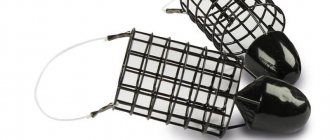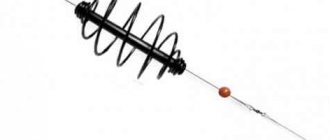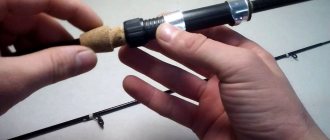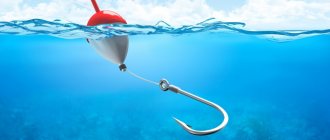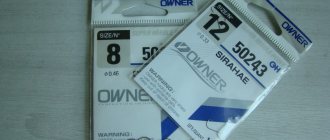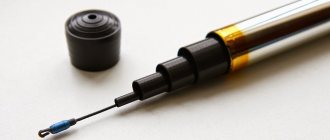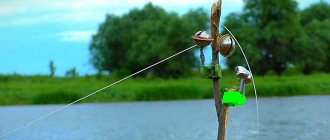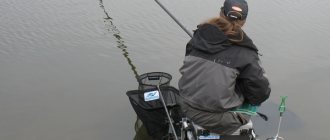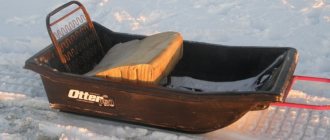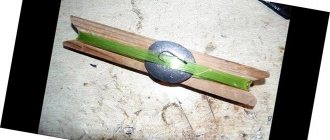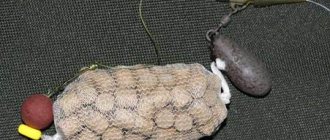Types of stands for feeder fishing
In the recent past, and even in our time, fishermen used the simplest stands made directly near the reservoir from various types of vegetation.
These were wooden pegs with slingshot-shaped extensions, where the fishing rod rested. Such wooden accessories can still be found on the shore. Unfortunately, this approach causes some damage to nature, although not significant. It’s good if there are thickets on the river bank that need permission, but if there are no such thickets, then what to do? Then you have to take such spears with you or make special stands from suitable material.
Many anglers use homemade butt holders, which do not always fit the feeder rod. They are good when the length of the rod is not long. If the rod is large, up to 5 meters, then such a holder will not work and you may not see a bite, especially in the presence of wind. Such holders need dense coastal soil, which is not always feasible, since the shore can be loose or sandy and the butt holder simply will not hold such a rod.
For feeder rods, it is possible to use single posts made of stainless steel or aluminum. They are convenient because they allow you to install rods at a certain distance from each other, which does not interfere with fishing with other rods. Such stands come in one- and two-piece types, which are height adjustable.
The most convenient to use are the types of pods that have 3 or 4 points of support. Stands with 4 support points are widely popular, as they are more stable and can be adjusted in height. Such stands are universal, which makes it possible to install them on any bank, setting the fishing rods at the desired angle.
The disadvantages of such structures include their bulkiness and the need to spend time on assembly and disassembly. In addition, pods cost a lot of money and not every fisherman can afford them.
Some fishermen make stands from metal wire with a diameter of 5-6mm. Both single stands and complexes for several fishing rods are made from this material. The places where the rod comes into contact with the metal should be wrapped with electrical tape or during installation of the stand, a cambric of the required diameter and the required length is put on the metal.
If you get creative, you can make a stand for a fishing rod from elements of a plastic hanger. The hook is removed from the hanger, and the excess elements are cut off. The lower part of the hanger is wrapped with thread, which is attached to glue. Winding is done every 5-7cm. This will make it possible to fix the rod and adjust the line tension by moving the rod along the stand.
For lovers of night biting, the option of a bell on a clothespin may be useful. This signaling device can be easily installed on any type of stand.
Homemade structures are much cheaper than purchased ones, especially ones like the pods. Some branded items can be purchased for no less than 20,000 rubles, while a homemade product can easily cost 100 rubles, and the result may be the same.
If it is not possible to purchase stands for the feeder in the store, then you can make homemade stands for any spinning rod. Most fishermen make stands from metal wire, the diameter of which is on average 5-6 mm. You can make a single support or a structure with several supports and designed for 2 or more fishing rods.
Be sure to wrap the places where the fishing rod comes into contact with the wire with electrical tape. Or you can put a cambric on the wire. You can choose different lengths and diameters, depending on the size of the structure you are going to make.
A tripod can be made from a plastic hanger. To do this, just remove the hook and cut off all excess. The lower part should be carefully wrapped with thread, which is filled with glue for strength. This type of winding on the hanger should be done every 5 centimeters.
For night fishing, you can make another version of the feeder stop, where a regular bell attached with a clothespin will act as a signaling device. You can install the bell on any stand that is available.
Structures for holding a feeder rod are much cheaper than store-bought devices, especially when compared with a rod-pod. Homemade racks will cost very little, and if you try, the result will be the same as using professional equipment.
There are two main types of feeder stands that can be found in stores - single stands and rod pods.
Single racks
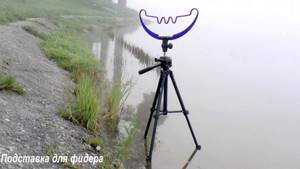
A single post is a structure whose bottom part is stuck into the ground. At the same time, in the upper part there is the rod holder itself, designed for one tackle. Such racks can be single-component, that is, non-removable, or multi-component, consisting of several elements.
When using single racks, they can be spaced apart from each other at any distance, thanks to which the likelihood of tangling the lines of two feeders with each other is minimized. The main disadvantage of this design is that the stand, which is stuck into the ground, cannot be used in rocky areas or when fishing from a plank pier or other plank structure located on the shore. In this case, a bucket filled with sand may be the solution.
Rod-pods
A rod-pod is a complex structure on which several feeders can be placed at once. It has several - from three to six - legs of adjustable height, so this stand can be placed on any bank.
The use of this design makes fishing very convenient; the disadvantages of rod-pods include the high price and the high risk of tangling the gear due to the fact that several rods are located on it close to each other.
Long gone are the days when anglers made most of their gear themselves. Feeder is an exception. There is enough gear available for fishing this way. You can just come to the store and buy everything you need - from a rod and reel to a seat and a box of feeders. And all this will work without additional modifications.
- Feeder rod - from scratch or converted from another
- Feeders
- Seats, platforms
- Sieves for bait
- Rod stands
- Advanced Fishing Reels
- cages
- Additional alarms
- Extractors
And many thousands of little things that a fisherman can make on his own and does not need to be bought in a store. In addition to completely homemade things, there are a lot of useful purchases that can be made more profitably in other stores than in special fishing stores. And they are perfect for feeder fishing, performing just as well as specialized ones.
We suggest you read: Which coil is better for a feeder
Any angler who is familiar with a feeder knows that rod tips are a consumable item. At least two or three break during the season, and you have to constantly buy them in the store. But you can make the ends for the feeder yourself, using cheaper components, and save up to 50% of money! Fiberglass tips are made.
It is better to do this in a large batch, about 20-30 pieces. To do this, you need to buy a semi-finished product in the store - fiberglass whips. The price of such a whip is from 1 to 2 dollars. The whip is clamped from the butt part into a drill, which is installed motionless in a vice. Then sandpaper is applied to it and it is ground down to the desired thickness.
After processing, the butt is ground down to the desired thickness that is suitable for your feeder. Rings from old broken quivertypes, store-bought or homemade, are installed on the tip. It is desirable that the rings be as light as possible and they need to be placed quite often. If you use a braided cord, it is better to buy rings with ceramic inserts.
At the end it is painted with bright colored nitro paint. The tips can be marked by placing it in the rod and seeing under what load it bends 90 degrees - this is the quivertip test. As a result, you can save up to $2 on each homemade feeder alarm if you buy all semi-finished products in bulk or use spare parts from broken gear. In the same way, you can make feeder nods, which are more used in bottom fishing.
Which coasters to choose
The Russian market has a wide range of rod stands suitable for different fishing conditions and rods.
We will describe the products of three companies that have received recognition from domestic fishermen and which should be paid close attention to.
Fox International (UK)
How to make a self-hooking fishing rod for summer fishing with your own hands
One of the leading European manufacturers of accessories for carp fishing. It is distinguished by high quality workmanship. They produce both single stands and rod-pods for several fishing rods. There is a representative office and online stores in the Russian Federation.
The company's products are of high quality and have original engineering solutions, but their prices are higher than those of less famous manufacturers. For example, a single electronic bite alarm costs about 6,000 rubles, and a regular replacement front holder for a stand without electronics costs 450 rubles.
Carp Pro (USA)
There is no official representative office in Russia. The company was originally registered in the USA, and the name suggests that it specializes in fishing tackle, equipment and accessories for carp fishing. However, after some time, a brand of the same name appeared in Ukraine, albeit with a different trademark from the North American one. And now Ukrainian managers represent the products, calling the company a local manufacturer.
Karp Pro supplies are high quality and convenient. For example, a rod-pod for 4 rods can be ready in a little more than a minute. The length of the stand and its tilt are adjustable. Total weight is about 3 kilograms. However, the cost of such a product is about 10 thousand rubles, and it cannot be called budget.
Kaida (China)
The company has become famous in Russia as a manufacturer of budget fishing gear and accessories. There is no official website, but there are several online stores presenting products from this manufacturer.
Kaida is best known for its spinning reels - high-quality and inexpensive. But rod stands also have their niche, since they are several times cheaper than those from the previous manufacturer. For example, a single plastic attachment for a stand with a threaded connection costs 20 rubles, versus the already mentioned 450 rubles for a metal holder from Fox.
Bushido (Japan)
Initially it was positioned as a Japanese manufacturer, but judging by its pricing policy, some goods began to be produced in countries with cheaper labor. Single attachments cost the same as Kaida's, complex stands are a little more expensive, but look very impressive.
Thus, the company’s stand for 4 rods costs about 7 thousand rubles, which is almost 3 thousand less than Carp Pro. But Bushido has original products, like an inexpensive (about 150 rubles) comb attachment for a stand.
Meccanica Vadese (Italy)
The products of the Italian company Mechanica stand out. The stand for feeders is mounted on a tripod, adjustable in height. The angle of the rod changes depending on the fishing conditions. Very high-quality elegant products, which, however, have a high price - from 20 thousand rubles.
Fishing with a feeder requires the rod to be stationary. The fisherman will be able to meet this condition only by using a high-quality stand for the fishing rod blank. Manufacturers provide a wide selection of products to suit every taste and financial capabilities. But you can start making racks yourself, if you have the ability and conditions.
DIY stands for feeder rods
It's no secret that not all anglers can afford a new rod at all. There are different situations in which you have to fish on a feeder with a homemade rod or a rod adapted for the feeder: the only working feeder broke on a previous fishing trip, you want to try a new type of fishing, but at the same time do not spend money on buying a new rod, you want to get an additional feeder rod in addition to the main one or or other options. Of course, a purchased rod specifically designed for feeder fishing will be better than a homemade one made by a non-professional.
Expert opinion
Chashchin Pavel
Federation of Fishing Sports of the Moscow Region
The easiest way to make it is to make a homemade telescopic feeder. To do this, you need to purchase a cheap telescopic spinning rod in the store, or use an old one. Even a rod with a broken upper leg will do.
manufacturing is as follows:
- The cap is removed from the lower knee and the tulip from the upper
- The upper knee is removed
- An insert is made into the penultimate elbow, which allows you to install a feeder tip of suitable diameter. Can be made from a hollow top elbow or any hollow tube.
- If necessary, the tip at the base is sharpened so that it fits there tightly enough.
That's it, the homemade telescopic feeder is ready. It unfolds, a coil is installed in it and the tip is placed. After this, they thread the fishing line through the rings, place the feeder and fish as with a regular feeder.
Another option is to use an adapted fishing rod. Quite soft spinning rods with a length of 2.4 to 2.7 meters are suitable. As a rule, these are cheap rods costing up to 1,500 rubles. The tip should be solid and quite thin. The material of such a spinning rod is only fiberglass, since you will have to throw it with overload, and cheap coal will immediately break.
It is unlikely that such a spinning rod will produce a full-fledged feeder, but you can use this rod as a picker. The solid tip will indicate a bite quite well.
It is recommended to throw a weight of no more than 40 grams, but when fishing on a pond this is quite enough. For comfortable fishing, you should change the rings on the upper knee to smaller ones and place them more often, every 20-30 cm. You should follow the line along which the rings were before. The monolithic tip will show a bite, and if necessary, it can be used for limited spinning fishing by placing another reel and fishing line and tying a spinner bait.
Is it worth converting a feeder rod from a spinning rod with insertable knees? No, it's not worth it. Usually such rods are quite expensive, and a ready-made feeder will cost less. And in terms of functionality, even an inexpensive purchased feeder will outperform a homemade one made by a beginner in rodbuilding. There is, however, an option to use broken spinning rods. The one with only the top near the tulip broken will do. It can be altered by making an insert for a replaceable tip.
Usually it takes a very long time to make a special feeder rod; it will still require additional costs for some materials, epoxy glue, and tools. Therefore, it is still recommended to purchase a ready-made rod for feeder fishing, but you can save on accessories.
For those who are not satisfied with the pricing policy in specialized stores, we can offer several options for creating a stand for the feeder from scrap materials.
- The following stand will fit well anywhere. Manufacturing requires a metal rod with a diameter of up to 10 mm and welding. Using a welding machine in any car service, you need to make a spear from a rod. The U-shaped cutout itself can be tightly wrapped with soft rubber. The rod can be installed straight or inclined. The only inconvenience is that on a rocky shore, the stand will need to be inserted into a bucket of stones.
- In order not to carry a heavy bucket with you, you can make a homemade tripod. To do this, buy a tripod for your camera at the store. You unscrew the factory rod at the top and insert a domestically produced nut there. Instead of a gasket, you can fix a piece of linoleum. We connect the tripod and the rod together and get a stand that will allow you to change the angle of the rod and install it, in principle, on any surface.
- Take a core of aluminum cable and a piece of nylon pipe. We make “blocks” from the pipe, in which we drill two holes. One across, all the way through, the second along, not all the way. It is necessary for vertical mounting into the ground. Remove the insulation from the core and thread it through the cross hole. Trim off the excess ends and finish the ends. Then put insulation on the entire length of the wire and bend it to the desired shape. Wind the wire from the bottom and sharpen it a little.
Rod-under
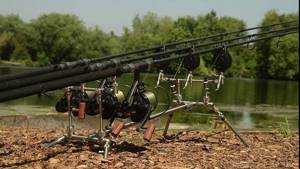
Strictly speaking, rod-pods designed to install 2–4 forms are more often used by carp fishermen, whose waiting time for a bite takes tens of minutes, or even hours. When fishing with classic feeder gear, recasts are done more often and the use of a rod-pod is not justified.
It is inconvenient to put and remove a feeder on a rod every two to three minutes, so such stands are used when fishing with a feeder using the method or flat method, when you have to reel in and cast the equipment much less often. The base of the rod-pod is four vertical posts located parallel to each other, or a tripod.
Electronic bite alarms are mounted on the front posts using screw connections, and butt screw holders are mounted on the rear posts. Three-leg stands allow you to adjust the angle of the rods over a wide range, but they are unstable in strong winds and this is their obvious drawback.
In such conditions, it is necessary to weight the structure with additional weights, which are hung on a special hook located at the bottom of the tripod. The stability of a four-legged rod-pod is higher, but its condition must be monitored and, if necessary, additional weight must be used. There are now a lot of rod pod models on offer and almost every fishing equipment manufacturer presents its own options.
The appearance, height, and additional adjustments may differ, but in general the designs are similar and provide high functionality. The main advantage of the rod-pod is that it can be installed on almost any surface, from soft soil to wood or concrete. In addition, several rods are installed on the rod-pod, and they are always located nearby, simplifying control of the gear.
It is very easy to raise or lower all the fishing rods mounted on such a stand at once, even without any serious physical effort. That is, it is convenient for the fisherman, when the wind increases or changes direction, to quickly change the line and height of the rods and ensure comfortable fishing.
If in the first years, after their appearance on the market, the cost of rod-pods was by no means budgetary, now there are many inexpensive models, so even those who do not have exorbitant incomes are able to buy such a stand. But before doing this, it is necessary to weigh all the pros and cons, and this applies specifically to feeder fishing.
Advantages of the pod:
- compact arrangement of several rods;
- installation on any surface, ground, concrete, wooden pavements;
- adjustment in rod direction and height;
- convenience for night fishing.
Disadvantages of rod-pods when fishing with a feeder:
- significantly higher cost than single racks;
- cumbersome design;
- long assembly and disassembly compared to other stands;
- inconvenience during tempo fishing.
That is, the disadvantages turn out to be more significant than the advantages and therefore feeders use rod-pods only when fishing with the method, or flat method, but not with the classic method.
Rohatina
The simplest version of the stand, which every feeder can make independently right on the pond, is a slingshot. All that is needed to make it is to cut a strong branching rod of suitable length, remove excess branches and leaves, sharpen the lower end and stick it into the ground.
We suggest you familiarize yourself with: Feeder equipment for crucian carp - viberilodku
This option for making a stand has significant disadvantages:
- such a stand has to be made every time after arriving at a reservoir;
- a suitable rod cannot be found everywhere, because fishing with a feeder often takes place in open areas, far from forests and bushes;
- the surface of the spear can scratch the rod;
- fishermen can cause significant damage to coastal vegetation by repeatedly cutting off branches from bushes and trees growing near a reservoir in large numbers.
From the hanger
To make a stand from a hanger, you will need:
- plastic clothes hanger;
- a piece of soft plastic tube;
- steel rod;
- wing nut, the diameter of the hole corresponding to the diameter of the rod;
- rod rack, which you need to buy in the store.
The feeder stand is made from a hanger in 6 stages:
- cut off the hook and all protruding parts from the hanger, leaving only an outline close in shape to a triangle or trapezoid;
- also saw off the bottom bar on which trousers are usually hung;
- glue in a piece of plastic tube instead of the sawn-off bottom bar - to keep it tightly, it is important to choose the right diameter based on the diameter of the hanger itself;
- on one side of the metal rod, cut a thread for a wing nut;
- using a nut, fasten the hanger and the metal rod so that the latter is in the place where the hook used to be;
- Insert the resulting rod stand into a standard stand.
You can also string knuckles from old hand abacus onto a piece of plastic tube. After the rod is installed on such a stand, it can be moved along it left and right, thus adjusting the direction of the fishing line and its tension. Thanks to this, you can adjust the tackle on the holder so that it shows bites as clearly as possible.
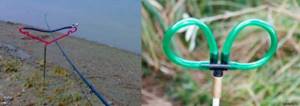
Another option is to leave the horizontal bar on the hanger without replacing it with a plastic tube. Instead, it can be wrapped with rope and secured with glue. Between the turns you need to leave a distance of one to several centimeters. In this case, the role of the rod lock will be played by the cord, and the tackle can also be moved left and right.
What are the advantages of fishing with feeder gear?
The advantages of this type of fishing lie in its compactness and mobility, because thanks to a small amount of equipment, the angler can move around the reservoir as needed in search of a promising place. At the same time, the use of feeder gear is justified both in currents and in still water, and in both cases it allows you to achieve very decent results.
Perhaps the main feature of the feeder is that the registration of bites when fishing with such a rod is carried out using a quiver tip, a flexible tip that sensitively reacts to the bite of even the smallest fish. That is, after casting the rig, the angler needs to remove the slack in the fishing line and tighten it so that the tip is in a slightly bent state. In anticipation of a bite, the rod is placed on a special stand, and I would like to talk about the manufacture of such a stand in this article.

Feeder feeders
Many people know that for feeder fishing you can make feeders yourself from lead and a plastic bottle. These are the so-called “chebaryukovkas”, named after the name of the inventor, which are an oblong lead weight with an eyelet for fastening and a plastic cylinder with holes attached to the top of the weight into which food is poured.
However, not everyone knows that the process of making a chebaryuk feeder can be simplified. For this, thickened plastic from a bottle is used. The bottle is heated over a fire, causing it to shrink slightly in size. The plastic of the bottle becomes much thicker. Feeders are made from this kind of plastic.
Plastic with holes made in it is immediately installed into the mold for casting sinkers, into which lead is poured during casting. Lead is not capable of melting thick plastic, and even if it does, it does not affect the functionality of the feeder. As a result, we get rid of the operation of attaching the sinker, and the attachment itself is more reliable.
The most important question is where to get lead. All the old lead-braided cables have long been dug up and handed over to homeless people, and it’s expensive to buy weights for tire fitting, which are recommended by most authors of videos on YouTube. A simple option is to purchase the largest “hare” shot by weight at a hunting store. It is the cheapest source of lead available to any angler and is sold without a gun permit.
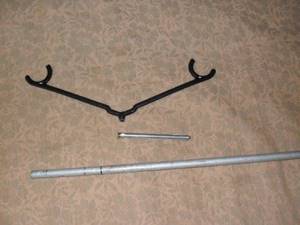
Using this method, you can make many feeder feeders with your own hands and not be afraid to unhook them. It is very technologically advanced and does not involve any precise operations or special tools such as a riveter. The only expensive component that can be recommended is an aluminum casting mold, which can be made to order at the factory.
DIY attachment table
Tables for making rigs and storing fishing baits are the cherished dream of every angler who is fond of feeder fishing. Purchased tables are unreasonably expensive, so it is better to make a table with your own hands from scrap materials.
The tabletop is made of a plastic or metal tray, and the legs are made of rigid plastic pipes for water or heating. In order to make the table collapsible to the bottom of the tray along its long edges, a pipe with corner joints is attached with self-tapping screws, into which the legs will be inserted during assembly.
When disassembled, the table will not take up much space, and assembling it while fishing will not be difficult. The use of a metal tray increases the durability of the structure, because such a table is resistant to significant mechanical loads.
Metal rod stand
This is a very easy-to-make and at the same time quite convenient version of the stand, for the manufacture of which you will only need two pieces of steel rod.
- One rod needs to be bent into an arc, on which the feeder rod will subsequently be located during fishing.
- The second piece will stick into the ground, so it needs to be sharpened by sharpening on one side.
- After this, you need to weld the stand itself.
- At the final stage, you need to put a soft tube on the holder's arc; another option is to wrap it with electrical tape or cord so that the rod does not beat or scratch against it.
Thus, the result is a simple, strong and reliable structure that will serve as a rod holder while fishing. To prevent the stand from damaging gear, things or upholstery during transportation, you can also put a tube on the pointed end.
However, this design has one drawback - the rod on the stand is fixed quite rigidly, and it cannot be moved from side to side, adjusting the position of the fishing line and its tension.
Therefore, you can make a slightly more complex version - a steel rod on which the feeder form is located during fishing, leave it straight, but attach either abacus knuckles or a rope to it. This is done in the same way as when making a structure from a hanger.
What are the requirements for feeder stands?
Feeder stands are subject to a number of basic requirements, based on compliance with which when selecting and manufacturing a device, the angler receives an effective and easy-to-use product that does not hinder fishing conditions, but helps improve them. The most important requirement is structural stability . The second most important requirement is the reliability of the design. Taken together, it is these conditions that have the greatest impact on the fishing process itself.
Requirements such as ease of assembly, convenient transportation dimensions, long service life, reliable attachment of the rod and quick removal of gear from the device during a bite are less significant, but increase the comfort of fishing and the performance of the stand. Recently, this is especially noticeable in such a direction of fishing as carp fishing, not only functionality is important for the fisherman, but also the overall attractive aesthetic appearance of the feeder stand, which is pleasantly pleasing to the eye.
Seats and platforms
Feeder fishing is associated with a fishing platform. This is a special seat for a fisherman, on which the necessary rod stands and accessories are attached. The platform is comfortable, has a backrest, a footrest and adjustable legs, with which you can install it even on a steep, uneven bank. For those who drive a car, the platform is very convenient.
Unfortunately, sitboxes and platforms are very expensive. A fairly high-quality and lightweight platform costs at least a thousand dollars. And good options with accessories are even more expensive. You can make a good platform yourself, using drawings and ready-made components, purchased in medical equipment stores, parts for shelving and other parts. As a result, the platform will cost you two to three times cheaper, plus a little time spent and a couple of tools for work.
A great option is to use a winter box instead of a sitbox. It's convenient, easy to carry to your fishing spot, and most anglers already have one. To install it on a slope, two methods are used - attach a pair of legs to it on one side or install it by digging the bank under it. Both options take the same time, unless, of course, you have to place it on a concrete slope where digging will not work.
Another seat option is a regular bucket. By the way, it’s better to buy it not in a fishing store, but in a construction store - it will cost three times less. It's comfortable to sit on the bucket. You can take a couple of buckets nested one inside the other. In one the bait is prepared, on the other they sit and put the fish in it. In order to sit comfortably, the lid is made of plywood and upholstered with soft material.
We invite you to familiarize yourself with: DIY feeder feeder: photos, diagrams, video
From the pipe
The feeder stand can be made from polypropylene plumbing pipe. For this you will need:
- board and nails;
- the plastic pipe itself is about 2 cm in diameter and half a meter long;
- thermal insulation for a pipe also half a meter long;
- burner, technical hair dryer or gas stove;
- a vertical stand that will stick into the ground;
- bolt and nut.
Polypropylene pipe can be easily bent, giving it a new shape. To do this, just heat it for a minute. After heating, the tube must be fixed in the desired position - when it cools, it will have the bends given to it.
To make a convenient feeder stand, you need:
- drive nails into the board, making a mold for making a holder from the pipe - the ends of the plastic pipe will need to be bent upward, one at a sharper angle, the other at a gentle angle;
- heat the pipe at the point of the first bend and insert it into the mold, secure it with a nail and let it cool, leaving it for a couple of minutes;
- give the pipe a second bend in the same way;
- in the middle of the resulting holder, drill a hole to attach a vertical pole that will be stuck into the ground;
- fasten the pole and holder with a bolt.
When making such a stand, the polypropylene tube can be given any shape, so there is always the opportunity to experiment, independently selecting the best option.
Using a feeder stand greatly simplifies the fishing process. Some fishermen prefer to cut a suitable rod each time they arrive at a pond and make a slingshot out of it, but a good stand that you can make with your own hands is much more convenient. Having made such a rod holder from scrap materials, you can use it for many years. At the same time, your fishing will be as comfortable as possible, which means you will get real pleasure from the fishing process.
First option
This method allows you to get the same results from use as expensive professional equipment.
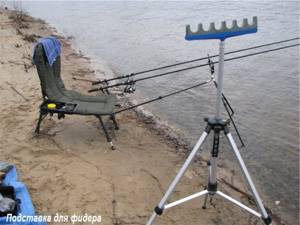
The classic homemade stand is made from a plastic pipe. For this design you will need:
- Polypropylene pipe, which is used for water pipes. It is better to choose a pipe with a diameter of 16-20 mm, length 45-50 cm. The pipe should be for cold water;
- Thermal insulation material of the same length;
- Burner, gas stove burner, technical hair dryer;
- Self-tapping screws and nails;
- A stick with which the structure will be installed in the ground;
- A blank made from a board and nails driven into it. This form will be needed to give the pipe the desired shape.
The advantage of a polypropylene pipe is that it can be easily processed by hand. You just need to heat the place you are going to bend and it will become soft. After this, fix the desired curvature and hold the pipe in this position for about a minute. The pipe will gradually cool down and become strong again.
Select the desired width, length and shape of the structure. Mark the bends on the pipe before heating it. When all the bends are ready, you need to cut off the excess pieces of pipe. Make a hole in the middle of the pipe for the stick. Lastly, place the insulating material on the tip of the feeder stand.
Other accessories
You can make a lot of other things for fishing - bait sieves, homemade leashes, anti-twisters, flat feeders for the feeder, etc. Also, many fishermen make homemade baits for the feeder, and they work no worse than mass-produced ones. On sale you can find self-cutters for feeders, the drawings of which are offered by a number of craftsmen, for money and for free.
Expert opinion
Chashchin Pavel
Federation of Fishing Sports of the Moscow Region
After all, the feeder originally began as fishing for the poor, when a feeder was made from curlers, a homemade stand was sharpened from a chair leg, and a fishing rod was used repurposed from a broken spinning rod. And he has great potential for improving his own gear, even those purchased in the store.
Purchase in store
There are a number of items that are used for fishing, and which are purchased in stores not for fishing, but in hardware stores.
- Buckets. It has already been said about their ability to be used as a seat. At the fishing store, the bucket says “sensas” on the bucket and costs five dollars. You can buy it at the hardware store for one or two dollars. If you wish, for two and a half, a milk bucket for food products. There is almost no difference in manufacturing quality. And if so, why pay more?
- Fishing suitcases. They are sold in fishing stores in the form of a box with a handle, which has a couple of compartments inside and small compartments on top where you can put hooks, clasps and feeders. This again can be bought at a hardware store at a price three times lower. By the way, it is very comfortable to sit on it if the shore is flat and the suitcase is large enough.
- Sectional boxes. These are boxes with a lid with a latch, with several compartments. Usually they store hooks, feeders, and other small accessories. In a fishing store, this will cost from three dollars and more. In a sewing store, these same boxes are sold for sewing supplies and cost two to three times less. You can give a lot more examples when you can simply buy the same thing cheaper and use it for fishing. However, the list is far from accurate, because sellers can change prices for their goods. The main thing that can be advised to fishermen is to look and you will find. You need to have a creative view of things and imagination, and you can always find a replacement for something that turns out to be unaffordable.
If you are thinking about the need to purchase this equipment, then the following brief excursion into the pricing policy for stands will be useful to you:
- Aluminum stand with adjustable length up to 120 cm. Designed to hold the fishing rod on the shore. Price – 181 rub. Aluminum stand
- Rod stand “Feeder Elite”. Has a standard thread. The rod is attached to the stand by screwing it on. It is possible to use several fishing rods at once. Price – 195 rub.
- The stand for the STONFO rod has a changed angle of inclination. STONFO has soft linings - they will not damage the rod. There are also recesses for fishing line. Length – 28 cm. Price – 305 rub.
- Stand for feeder “Browning”. It has a soft base that will not harm your fishing rod. Length – 32 cm. This will allow you to place several fishing rods at once. Price – 570 rub. "Browning"
- "Offbox Method Feeder Rest". The stand is designed for fishing using the “method” method. The curved shape allows the form to move freely horizontally. At the same time, its ends prevent the feeder from falling out. The stand is equipped with a soft pad. Price – 770 rub.
- Telescopic stand "Tough Pod Browning". The holder is made in the form of a telescope with a thread. It has stable legs for a hard bottom. This stand is easy to assemble. Can be purchased complete with a soft case. Price – 1,705 rubles.

